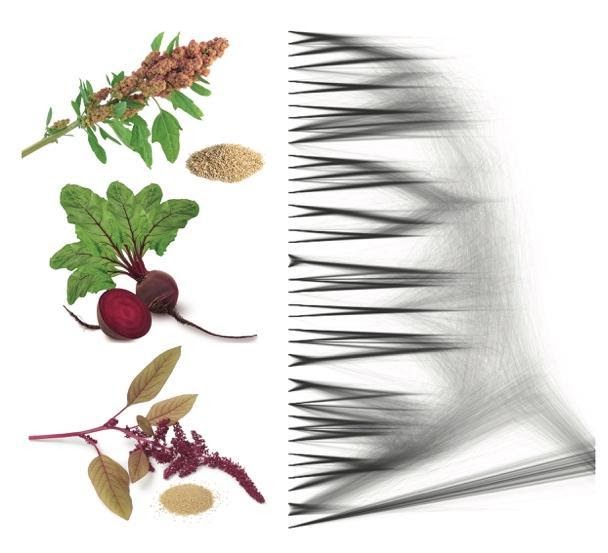Plants inhabit many environments across the globe, and some groups can survive extreme conditions. One of these groups is the amaranth family. Members of this family, including several important crops such as amaranth, quinoa, spinach, and sugar beet, are well known for evolving adaptations to survive extreme environments, such as C4 photosynthesis in hot and often dry places and tolerance to highly elevated levels of salt or heavy metals.
A clear understanding of the mechanisms that members of the amaranth family evolved to endure extreme conditions can provide insights about plant adaptations as well as help identify species that can be used as fodder plants in arid regions or plants that have soil remediating and desalinating effects. But, in order to accomplish this, a clear understanding of the affinities among species is fundamental, something that is largely questioned and unsolved in the amaranth family.
Traditionally, quinoa and relatives, known as chenopods, are considered to be members of their own family segregated from the amaranths, which has long been the subject of taxonomic debate. The affinities and differences between amaranths and chenopods are well established, but the key problem in this debate are two small groups, beets and niteworts, and their affinities with either amaranths or chenopods. Beets and niteworts share morphological and ecological characters with both amaranths and chenopods, and some researchers suggest this as evidence for an ancient hybrid origin of beets and niteworts.
My research focused on clarifying the affinities between amaranths, chenopods, beets, and niteworts, while testing for the hybrid origin of the latter two. By analyzing DNA sequences from thousands of genes, I discovered that multiple natural population-level processes, including incomplete lineage sorting — when a lineage has failed to sort out during speciation — and hybridization, during the origin and evolutionary history of these groups produce conflicting signals that impede teasing apart the relationships among these groups. These findings suggest that plant groups that contain amaranths, chenopods, beets, and niteworts experienced ancient and rapid diversifications and that their relationships remain, and probably will remain, unresolved.
While the pattern seen in the amaranth family is uncommon, studies in other groups of plants like the legume family have started to reveal similar results. Interestingly, the amaranth and legume families share a similar evolutionary time frame with an estimated origin around 66 million years ago. This timing is consistent with the rapid origin of other groups across the tree of life, like some mammals and birds, that are associated with a mass extinction event that produced a major turnover of the world’s animal and plant diversity, including the extinction of non-avian dinosaurs.

The figure is showing (left) a plant of quinoa, beet, and amaranth. On the right, a ‘cloudogram’ depicting fuzzy relationships between most members of the amaranth family.
Image citations: Amaranthus hypochondriacus by Picture Partners, Beta vulgaris by Olha Huchek, Chenopodium quinoa by Diana Mower.
Morales-Briones, D.F., G. Kadereit, D.T. Tefarikis, M.J. Moore, S.A. Smith, S.F. Brockington, A. Timoneda, W.C. Yim, J.C. Cushman & Y. Yang. 2020. Disentangling sources of gene tree discordance in phylogenomic data sets: testing ancient hybridizations in Amaranthaceae s.l. Systematic Biology. syaa066. doi.org/10.1093/sysbio/syaa066